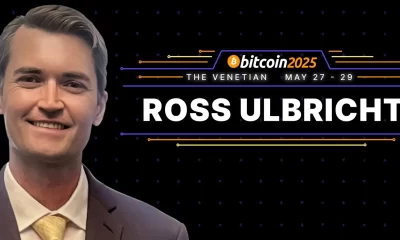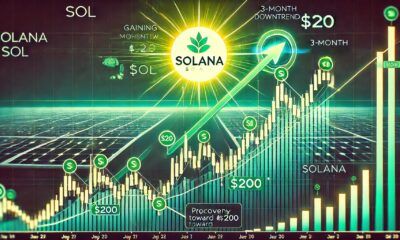Markets
Michael Saylor’s MSTR to Be in Invesco QQQ ETF After Nasdaq-100 Inclusion
Published
4 months agoon
By
admin

MicroStrategy (MSTR) is set to soon be included in of the world’s largest exchange-traded funds after becoming the first bitcoin-centric company to win entry into the Nasdaq-100 Index.
The Nasdaq-100 Index tracks the 100 largest non-financial companies listed on the Nasdaq exchange and is filled with dominant market names like Apple, Nvidia, Microsoft, Amazon, Meta, Tesla and Costco.
The price of bitcoin (BTC) added modestly to earlier gains, topping $102,000 in the minutes following the Friday 8 pm ET press release from Nasdaq announcing the inclusion.
On Nov. 29, the day when the Nasdaq took a market snapshot in preparation for the index’s annual rebalancing, MicroStrategy had a market cap of roughly $92 billion. That would rank the Michael Saylor-led company as the 40th largest in the Nasdaq 100 and a likely weighting in the index of 0.47%, according to Bloomberg Intelligence senior ETF analyst Eric Balchunas.
As comparison, Apple — prior to this year’s rebalancing — had the index’s largest weighting at just under 9%; Qualcomm had the 20th largest weighting at just above 1%.
The addition will exponentially increase the Nasdaq 100’s exposure to bitcoin (BTC), of which MicroStrategy owns about $42 billion worth, and expose MSTR to billions in passive investment. ETFs tracking the Nasdaq 100 have more than $550 billion in assets under management, said Balchunas. Easily the largest is Invesco’s QQQ Trust (QQQ) with more than $300 billion in AUM.
“The inclusion of MicroStrategy entering the Nasdaq 100 is possibly the second biggest story of 2024, after the launch of the US spot listed ETFs,” said James Van Straten, senior analyst at CoinDesk. “These funds are often buyers at any price level on a monthly basis which will add to another buyer of MSTR, when Michael Saylor continues to issue the at-the-market (ATM) offering, to dilute shareholders but will have a bigger base of buyers.”
Balchunas’ colleague James Seyffart cautions that there’s a chance that MicroStrategy’s inclusion in the index might be short-lived as the company could be re-classified as a financial firm in March since its value comes almost entirely from its bitcoin holdings and not the actual operating business. MicroStrategy founder and Executive Michael Saylor has even said previously that he plans to turn the company into a “bitcoin bank,” making it even less of a technology operation.
“The game theory now sees the SPDR S&P 500 Trust (SPY), the largest of all ETFs with about $650 billion in AUM, as maybe needing to include MSTR to rival their competitor,” van Straten added. “Millions of investors will now have indirect bitcoin exposure adding to the flywheel effect.”
The re-shuffling of the Nasdaq 100 and consequently the QQQ and related ETFs will go into effect on Dec. 23.
Source link
You may like


CryptoPunks NFT Sells for $6 Million in Ethereum—At a $10 Million Loss


SEC drops suit against Helium for alleged securities violations


Tokenized Gold Nears $2B Market Cap as Tariff Fears Spark Safe Haven Trade


Ross Ulbricht To Speak At Bitcoin 2025


Solana Eyes $200 Target As It Gains Momentum – Recovery Could Mirror 3-Month Downtrend


BTC-denominated insurance firm meanwhile secures $40m in VC funding
CEX.io
Tokenized Gold Nears $2B Market Cap as Tariff Fears Spark Safe Haven Trade
Published
3 hours agoon
April 10, 2025By
admin
As risk assets including cryptocurrencies struggled on Thursday amid tariff uncertainties, tokenized gold once again emerged as an outperformer in the carnage.
The market capitalization of gold-backed tokens swelled to just under $2 billion on Wednesday, up 5.7% over the past 24 hours, according to CoinGecko data. The rise coincided with the yellow metal briefly touching a fresh all-time above $3,170/oz, TradingView shows.
Alongside the price rally, gold tokens experienced a frenzy of activity and demand over the past weeks, fueled by the broader market turmoil. Weekly tokenized gold trading volume surpassed $1 billion, the highest since the U.S. banking turmoil of March 2023, according to a report by digital asset platform CEX.IO.
The two largest tokens, Paxos Gold (PAXG), Tether Gold (XAUT), making up the bulk of the tokenized gold market, saw their weekly trading volumes surging over 900% and 300%, respectively, since January 20, according to the report citing CoinGecko data. PAXG also experienced continuous inflows totalling $63 million during this period, DefiLlama data shows.
The rally tracks the broader gains in physical gold, which posted double-digit increases in 2025 amid geopolitical uncertainty and inflation concerns. However, even gold wasn’t spared during the market-wide sell-off triggered by U.S. tariffs, with prices briefly dropping 6% before quickly recovering to record highs.
Since Trump’s inauguration, tokenized gold has been one of crypto’s top performing sectors, with its market cap up 21%, the report noted. By contrast, stablecoins gained a more modest 8% in market cap, while bitcoin declined 19% and the total crypto market lost 26%.

“Tokenized gold is emerging as one of the key diversification strategies among crypto-native users, alongside bitcoin,” wrote Alexandr Kerya, VP of product management at CEX.IO. “It provides a safer and more stable approach to portfolio management, enabling users to stay within the crypto ecosystem while benefiting from the value and stability of the underlying physical asset.”
“At the same time, the broader RWA narrative helps make gold exposure more accessible and intuitive for users who may not have considered it before,” Kerya added.
Disclaimer: This article, or parts of it, was generated with assistance from AI tools and reviewed by our editorial team to ensure accuracy and adherence to our standards. For more information, see CoinDesk’s full AI Policy.
Source link
analysts
Tariffs, Trade Tensions May Be Positive for Bitcoin (BTC) Adoption in Medium Term: Grayscale
Published
11 hours agoon
April 10, 2025By
admin

Tariffs and trade tensions could ultimately be positive for bitcoin (BTC) adoption in the medium term, asset manager Grayscale said in a research report Wednesday.
Higher tariffs result in stagflation— stagnant economic growth coupled with inflation — which is negative for traditional assets, but positive for scarce commodities such as gold, the report said.
Bitcoin is considered hard money, akin to digital gold, and is viewed as a modern store of value, the report noted.
Cryptocurrencies surged on Wednesday following President Donald Trump’s announcement of a 90-day pause on tariffs for countries that haven’t retaliated against the U.S.
“Trade tensions may put pressure on reserve demand for the U.S. Dollar, opening space for competing assets, including other fiat currencies, gold, and bitcoin,” Grayscale said.
Historical precedent suggests that dollar weakness and above-average inflation may persist, and bitcoin is likely to benefit from such a macro backdrop, the asset manager said.
“A rapidly improving market structure, supported by U.S. government policy changes” could help broaden bitcoin’s investor base, the report added.
Read more: Trump Administration Wants Weaker Dollar and That’s Positive for Bitcoin: Bitwise
Source link
Bitcoin
‘Investors Will Buy Bitcoin and Gold’ Amid Yield Spike, ByteTree’s Morris Says
Published
1 day agoon
April 9, 2025By
admin

As of Wednesday morning, the yield on the UK’s 30-year government bond soared to 5.5%—its highest level since 1998—mirroring a broader climb in U.S. sovereign yields and sparking fresh concerns about financial market stability.
Surging global bond yields are exerting significant downward pressure on risk assets. Since the U.S. equity sell-off began last Thursday, the Nasdaq has dropped 10%, while bitcoin (BTC) has fared slightly better, down 8% over the same period.
In the same time the U.K. 30-year bond yield is up 8%, while the U.S. 30-year is up 12%. Charlie Morris, founder of ByteTree, believes investors will start to seek diversification into other assets including bitcoin.
“It appears that the UK has been living beyond its means for too long. It hasn’t balanced its budget since 2001, the gilt market has had enough”, Morris said. “Investors seeking diversification away from financial assets will not only buy gold, but bitcoin too”.
The dramatic spike in yields has revived unsettling memories of the UK’s 2022 pension crisis, when a sudden surge in borrowing costs triggered a near-collapse of the financial system and ultimately cost then-Prime Minister Liz Truss her job.
This latest bond market turmoil is being driven by escalating uncertainty around global trade, stoked by President Donald Trump’s proposed tariff plans. These levies could disrupt global supply chains and increase costs, adding pressure to already jittery markets.
“Alas, in politics you never get what you want by making civil arguments from high principle,” former UK MP Steve Baker told CoinDesk in an exclusive interview. “President Trump said he was using brute economic force—and he is. It’s time to rediscover free trade at home and abroad, fast, before this chaos wrecks our futures.”
The recent yield surge echoes the events of 2022, when a surprise mini-budget announcement on Sept. 23 sent gilt yields soaring, crashed the pound, and exposed deep vulnerabilities in the UK pension system.
Many defined benefit pension schemes had adopted complex liability-driven investment (LDI) strategies, using leverage and derivatives to match long-term liabilities. But as yields spiked, these funds suffered massive mark-to-market losses and faced margin calls, forcing rapid gilt sales into a thin market and creating a destabilizing “fire sale” feedback loop.
At the time, UK pension funds held around 28% of the gilt market. The ensuing chaos, occurring in a modest $1.5 trillion market, was so severe that it required the Bank of England to step in with emergency gilt purchases to halt the downward spiral. A Chicago Fed Letter analyzing the crisis later identified excessive leverage, asset pooling, and the limited depth of the gilt market as key structural weaknesses—particularly in contrast to the much larger $9.9 trillion U.S. Treasury market.
Source link

CryptoPunks NFT Sells for $6 Million in Ethereum—At a $10 Million Loss

SEC drops suit against Helium for alleged securities violations

Tokenized Gold Nears $2B Market Cap as Tariff Fears Spark Safe Haven Trade

Ross Ulbricht To Speak At Bitcoin 2025

Solana Eyes $200 Target As It Gains Momentum – Recovery Could Mirror 3-Month Downtrend

BTC-denominated insurance firm meanwhile secures $40m in VC funding

‘You Want To Own the Most Hated Thing’ – Arthur Hayes Says Ethereum Set To Outrun Solana As Memecoin Craze Fades

Crypto Braces for a Hidden $4.5 Trillion Catalyst for Bitcoin, Ethereum, Cardano, XRP Price

Block Agrees to $40M NYDFS Penalty Over Lackluster Compliance Program

Top Bitcoin miners produced nearly $800M of BTC in Q1 2025

Tariffs, Trade Tensions May Be Positive for Bitcoin (BTC) Adoption in Medium Term: Grayscale

The U.S. Tariff War With China Is Good For Bitcoin Mining

Dogecoin Bull Div Plays Out, Analyst Maps Next Price Targets

Web3 search engine can reshape the internet’s future

Billionaire Ray Dalio Says He’s ‘Very Concerned’ About Trump Tariffs, Predicts Worldwide Economic Slowdown

Arthur Hayes, Murad’s Prediction For Meme Coins, AI & DeFi Coins For 2025

Expert Sees Bitcoin Dipping To $50K While Bullish Signs Persist

Aptos Leverages Chainlink To Enhance Scalability and Data Access

Bitcoin Could Rally to $80,000 on the Eve of US Elections

Crypto’s Big Trump Gamble Is Risky

Sonic Now ‘Golden Standard’ of Layer-2s After Scaling Transactions to 16,000+ per Second, Says Andre Cronje

Institutional Investors Go All In on Crypto as 57% Plan to Boost Allocations as Bull Run Heats Up, Sygnum Survey Reveals

Ripple-SEC Case Ends, But These 3 Rivals Could Jump 500x

Has The Bitcoin Price Already Peaked?

A16z-backed Espresso announces mainnet launch of core product

The Future of Bitcoin: Scaling, Institutional Adoption, and Strategic Reserves with Rich Rines

Xmas Altcoin Rally Insights by BNM Agent I

Blockchain groups challenge new broker reporting rule

I’m Grateful for Trump’s Embrace of Bitcoin

Trump’s Coin Is About As Revolutionary As OneCoin
Trending

 24/7 Cryptocurrency News5 months ago
24/7 Cryptocurrency News5 months agoArthur Hayes, Murad’s Prediction For Meme Coins, AI & DeFi Coins For 2025

 Bitcoin3 months ago
Bitcoin3 months agoExpert Sees Bitcoin Dipping To $50K While Bullish Signs Persist

 24/7 Cryptocurrency News3 months ago
24/7 Cryptocurrency News3 months agoAptos Leverages Chainlink To Enhance Scalability and Data Access

 Bitcoin5 months ago
Bitcoin5 months agoBitcoin Could Rally to $80,000 on the Eve of US Elections

 Opinion5 months ago
Opinion5 months agoCrypto’s Big Trump Gamble Is Risky

 Altcoins2 months ago
Altcoins2 months agoSonic Now ‘Golden Standard’ of Layer-2s After Scaling Transactions to 16,000+ per Second, Says Andre Cronje

 Bitcoin5 months ago
Bitcoin5 months agoInstitutional Investors Go All In on Crypto as 57% Plan to Boost Allocations as Bull Run Heats Up, Sygnum Survey Reveals

 Price analysis5 months ago
Price analysis5 months agoRipple-SEC Case Ends, But These 3 Rivals Could Jump 500x


